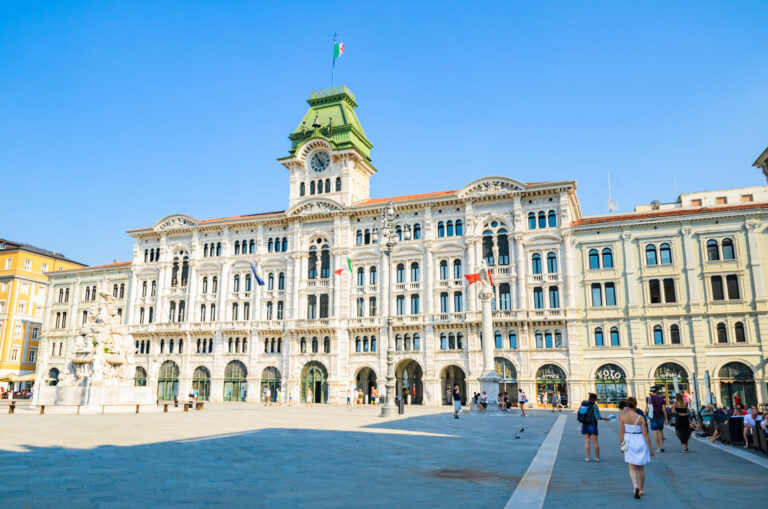Most Beautiful Coastal Towns in Italy
Italy is blessed with over 7000 kilometres of coastline that stretches down the Italian Riviera and winds around the iconic boot shape, before cruising back up and east to Trieste. And that’s before we get started on the elegant Italian Islands! It is little wonder then, that Italy has no shortage of beautiful towns and seaside villages nestled along its sublime coast.
With so many idyllic settlements to discover, how on earth do you decide where to visit? Although just looking at a map and picking a town at random will likely get you a good result – after all, this region is littered with stunning seascapes and world-class cuisine – sometimes choosing the right town for you can take a little more leg work.
Luckily, we’ve spent several years touring the Italian coast, and have compiled a list of our favourite places along the way. Discover the best Italian Coastal Towns below!
Camogli, Liguria

Dotted with some of the best coastal towns in the country, the adeptly named Golfo Paradiso (Gulf of Paradise), is located on the Italian Riviera just east of Genoa. Camogli attracts with its colourful houses overlooking the deep blue sea and is one of the largest areas of the Parco Naturale Regionale di Portofino, as well as the Portofino Marine Protected Area.
Enjoy some strong espresso in one of the many little bars lining the seaside before strolling over to Basilica di Santa Maria Assunta, built directly adjoining the water, with its impressive interior entirely covered with fine stuccos in gold and polychrome marble.

According to local legend, Camogli gets its name from the history of seafaring: as the men were on the water most of the year, the town was populated by women and therefore got the nickname Casa Del Mogli, the house of wives, later shortened to Camogli.
A special day to visit is the second Sunday of May when the whole town celebrates La Sagra del Pesce, a holiday to honour the fish that sustain the town. The whole town is decorated and in the central square a frying pan spanning four meters across fries up three tons of fish for hungry locals and visitors alike.
Portofino, Liguria

No trip to Italy would be complete without witnessing the old-world charm of Portofino. Once the stomping ground of ancient Romans, the name comes from “Portus Delphini” (Port of the Dolphin), due to the number of dolphins who used to inhabit the Tigullian Gulf.
The small harbour is framed by pastel-coloured houses and lush green hills. At its centre, the Piazzetta welcomes you to enjoy a coffee or glass of wine and a spot of people-watching. Who knows, you may even spot a celebrity among the mix!


Portofino is a town of contrasts. The superyachts parked at the mouth of the harbour in juxtaposition with the wooden fishing boats bobbing in the bay. In town, luxury fashion stores share walls with gelaterias and bakeries selling freshly baked focaccia.
Take a short walk up to Castello Brown for the best views in town, and if you’ve got a little more energy, hit one of the trails in the Portofino Regional Park. One such trail will lead you to the ethereal San Fruttuoso Bay with its beachside abbey and Doria Tower.
The spectacle continues underwater too – don your scuba gear to explore the area’s rich marine life and somewhat spooky underwater statue, the Christ of the Abyss.
Monterosso al Mare (& the Cinque Terre), Liguria

This tiny Italian coastal resort – numbering just 1400 inhabitants – might seem familiar to Disney lovers, as it was one of the towns (the other being nearby Vernazza) that served as inspiration for the fictional town of Portorosso in the 2021 animated film Luca. Don’t worry, though, the turquoise waters in front of this town are free from sea monsters!
Monterosso is part of the Cinque Terre (“Five Lands”) coastal area, consisting of five towns gripping the rocky cliffs above the Ligurian Sea. They are famous for their rustic charm and can best be reached by train, boat, or on foot, as the roads are steep and treacherous. Hop between the towns of the Cinque Terre on day trips and savour the unique beauty of each.

Leaving the train station in Monterosso will land you squarely on the beach of Fegina, hosting both paid and free swimming spots. If you have always dreamed of bathing under the protective eye of a stone giant, the Gigante beach further down the coast lives up to its name with an imposing statue carved directly into the cliff.
Don’t miss out on the local specialities of anchovies, wine made from locally grown grapes, olives, and farinata – a crunchy pancake made with chickpea flour.
Read More: Best Beaches in the Cinque Terre, Italy
Portovenere, Liguria

Somewhat of a hidden gem on the Ligurian Coast, Portovenere lies along the same languid coastline as the five villages of the Cinque Terre (which it shares its UNESCO world heritage site status with) and the star-studded Portofino. Beloved by locals, but often overlooked by visitors, it’s a seaside Italian town that’s brimming with personality, a rich history, and natural beauty.
Portovenere is easily reached via La Spezia by car, train or boat. The journey only takes around 30 minutes and passes by a few other charming villages on the way. When you arrive, continue your exploration on foot. Head up into the old town via the Porta del Borgo, and discover the maze of laneways and staircases within. Make your way up to the top of the village where you’ll find the Doria Castle, and pause to take in the views.

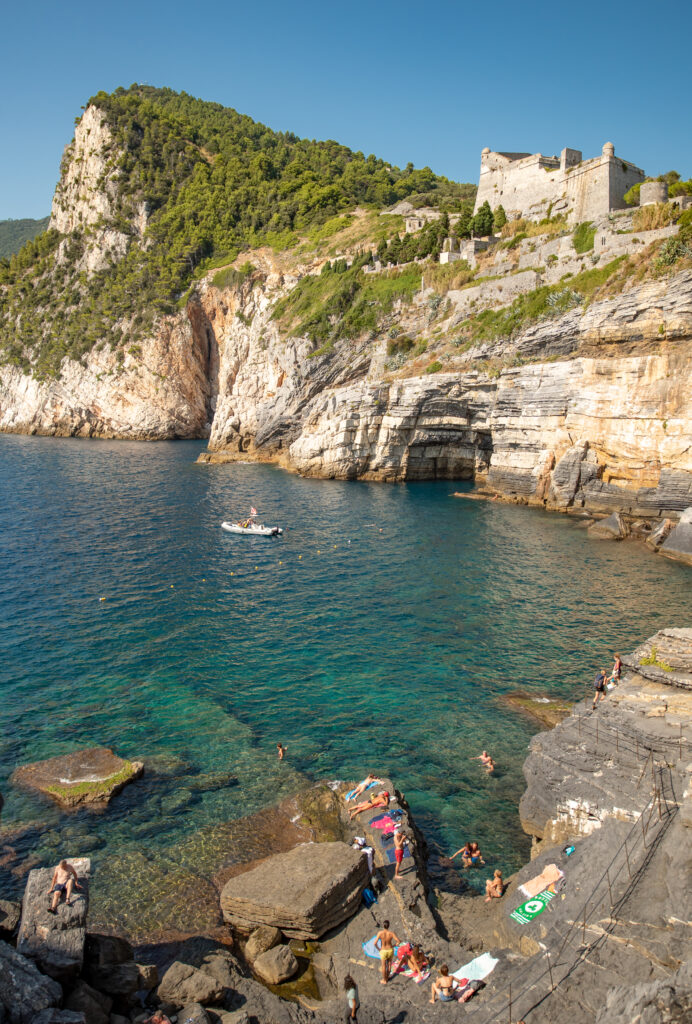
Make a pitstop for gelato or fresh pasta with homemade pesto in the main pedestrianised alleyways, before making your way down to the Church of Saint Peter with its magnificent loggia of San Pietro next door. If you fancy a dip after your walking, there’s no better place than Byron’s Grotto – a favourite spot of the late poet, Lord Byron.
If time allows, you can take a boat trip to or around the neighbouring islands of Palmaria, Tino and Tinetto. Or, you can simply settle into a waterfront bistro for some prime people-watching.
Read More: A Guide to Portovenere – Liguria’s Lesser-Known Jewel
Marciana Marina, Elba Island
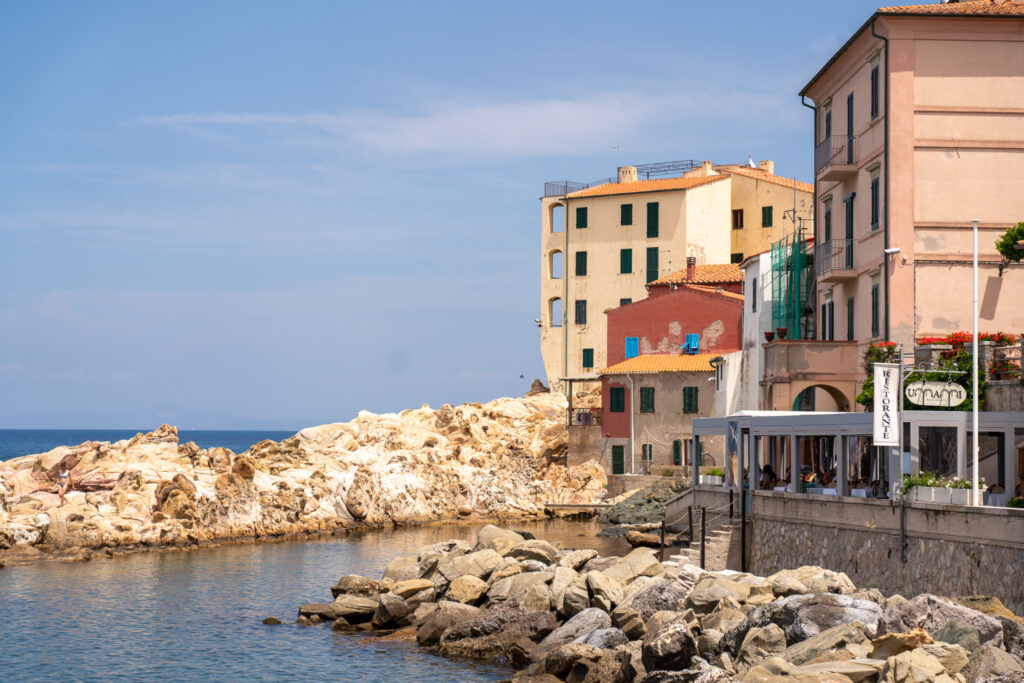
Sitting pretty on the northern coast of Elba Island, off the coast of Tuscany, is Marciana Marina. The seaside settlement sits below Marciana, its hilltop sibling, and it quickly won me over with its quaint streets and easy-going charm.
The harbour is a focal point, for obvious reasons, and it’s a hive of local activity. Watch the colourful fishing boats bringing in the catch of the day, and elegant sail boats sinking anchor to drink in their surroundings.


Besides topping up your tan on the town’s picturesque beaches, there isn’t a whole lot to do here, but that’s the magic of it. Enjoy a lazy lunch by the water’s edge, wander the pretty streets with a gelato in hand, and stroll out to the Saracen Watchtower standing guard at the entrance to the port.
Marciana Marina’s charm extends beyond its pretty flower-filled streets though. It hosts a variety of cultural festivals and musical events throughout the year, including the festive “Living Nativity Scene” which takes place at Christmas and transforms the town into a fairytale.
Read More: Guide to Visiting Elba Island, Italy
San Teodoro, Sardinia

A little smaller than Sicily, but much more sparingly populated, the second-largest island of the Mediterranean holds interesting linguistic pluralities to its southern counterpart. Although Italian is the dominant language of public life, most Sardinians also speak Sardo, a romance language widely considered to be the closest to ancient Latin.
San Teodoro is located at the northern tip of Sardinia and is one of the most versatile Italian seaside towns. Sports fans can swim, surf and dive in the clear blue waters, while families can play in the white sand, and dog owners have a full beach just to themselves.
In the evenings, San Teodoro offers restaurants, bars, and clubs where one can party till late or simply sip an aperitivo while contemplating the Tyrrhenian Sea.
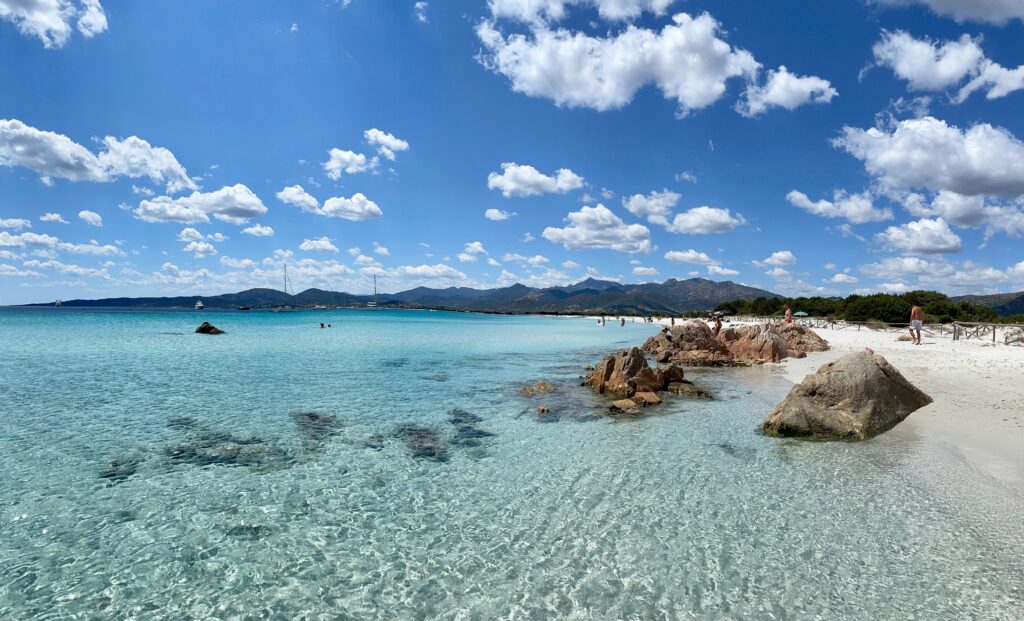
If you need a break from the hustle and bustle, simply venture into the island itself. Just behind the town lies the marsh Stagno di San Teodoro, where numerous wild bird species live, including wild flamingos.
Where San Teodoro is a hubbub of tourism, the inner country of Sardinia is still mostly unexplored and a haven for travellers looking to experience real island life.
Read More: Best Beaches in Sardinia, Italy
Sant’Angelo, Ischia

Once a simple fishing village, now a tourist hot spot, Sant’Angelo has retained its traditional character and unique appeal, despite its increase in popularity. The largely car-free centre is a maze of narrow streets where captivating views and charismatic courtyards surprise at every turn.
Celebrated for its thermal springs and mud baths, the waters around this small town in Ischia are believed to have healing properties. Hop on a water taxi to reach the nearby beach at Sorgeto Bay and relax in warm rock pools with mineral-rich waters.

The village is adorned with a sandy isthmus connecting the mainland to a rocky island at one end of the port. Sadly, you can’t walk around the island, so you’ll have to take a boat trip to view the Elephant Arc hiding on the other side!
Relax into the Italian lido way of life, watch kids cliff-jumping off the rocks, hire a pedalo or paddle board to navigate the bay, stock up on Italian linens in the nearby boutiques, or fill up on fresh seafood dishes before ending your day with sunset cocktails on a restaurant terrace.
Read More: Best Things to do in Ischia, Italy
Procida, Campania

The star of many a magazine cover, Procida Island was thrust into the limelight when it was crowned the Italian Capital of Culture in 2022. But despite its new-found fame, it remains less frequented by tourists than its glitzier neighbour in the Bay of Naples, Capri.
Procida’s main town is the star of the show, and it’s here you’ll find the breathtaking views the island is known for. Pastel-toned buildings cascade down the hill towards the turquoise sea, and a sunshine-yellow church tops the scene.
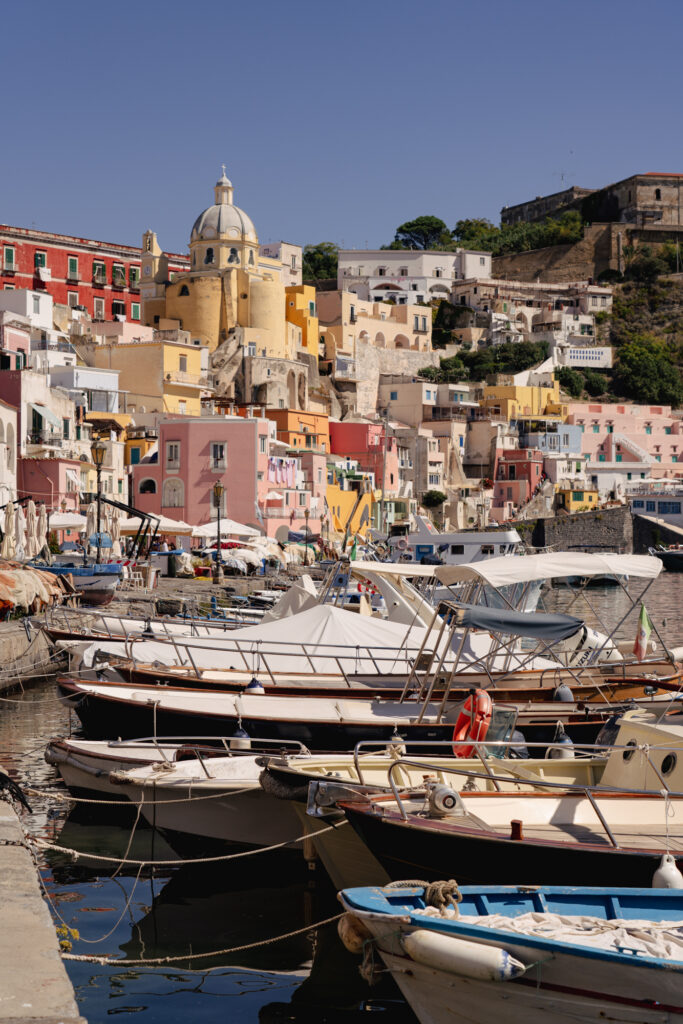
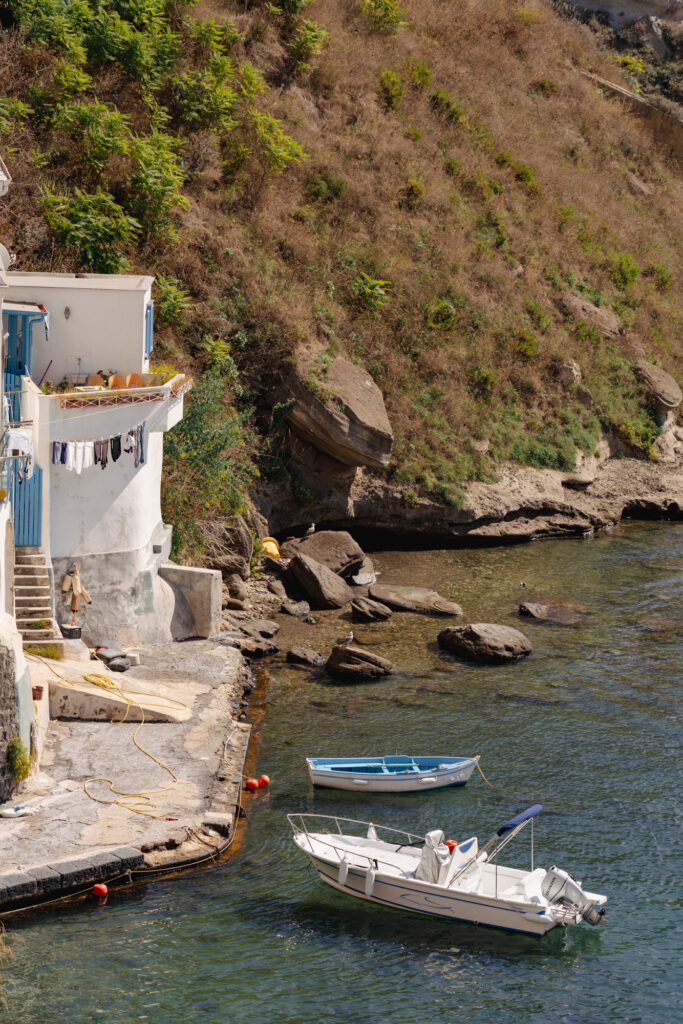
Stroll the waterfront promenade and settle into a shaded table to feast on the local lemon salad. Wander past cats eyeing up the fishermen’s catch, and dip into delightful boutiques selling everything from Limoncello to locally crafted clothing.
Climb the stairs to delve further into the village, visit the Casale Vascello neighbourhood and explore the fortified village at Terra Murata. Step back in time at the Graziella House Museum which shows how the locals lived some 200 years ago, and take a tour of Palazzo d’Avalos to hear tales of its storied past.
Read More: Complete Guide to Visiting Procida Island, Italy
Amalfi (and Atrani), Campania

The name giver of the famous Amalfi coast – Costiera Amalfitana in Italian – Amalfi looks like something out of a Renaissance painting. Climbing up the slope of Monte Cerreto, this village hosts a large harbour, beautiful sand beaches and tiny houses dotting green hills. Outside of the town, wild rivers, gushing waterfalls and the breathtaking nature of Valle delle Ferriere await you.
Although it is hard to believe when strolling through the narrow streets, Amalfi once was a maritime power rivalling Pisa and Genoa in prosperity and power and numbered up to 80,000 inhabitants. After political intrigue weakened the local government and a tsunami destroyed the port in 1343, it never recovered more than local importance and shrunk to its modern size of 5,000 inhabitants.

Thanks to its former high position, Amalfi hosts fantastic architectural sights blending Byzantine style with the forms and sharp lines of northern architecture. The most famous example of this is the majestic Duomo di Sant’Andrea, an absolute must-see for visitors.
Walk through a pedestrian tunnel to Atrani next door and you’ll be further delighted by the smaller town’s picturesque beaches, medieval architecture and colourful tiered houses.
Amalfi and Atrani are two of the most beautiful beach towns and are best visited during spring and autumn for a less crowded experience. Hop over to see the ancient ruins of Pompeii, Mount Vesuvius, and Naples, the birthplace of pizza; all just two hours away.
Cefalu, Sicily

No guide to Italian beach towns would be complete without mentioning the largest island in the Mediterranean Sea, Sicily. Cefalu is located on the northern side of Sicily, the island reminiscent of a football at the toe of Italy’s “boot”.
Like most cities in Sicily, it was founded by Greek settlers who controlled large parts of modern-day southern Italy before the region was conquered by the Romans. Later it came under Byzantine, Arab and Norman rule before being joined into the Kingdom of Italy.

Cefalu’s beach offers a break from the rough, stony cliffs and inaccessible bays that dominate the northern stretch of coastline in Sicily, instead shining with a 1.5-kilometre-long beach with fine white sand, ideal for families with children.
Only fifteen kilometres away lies the Santuario di Gibilmanna, overlooking the bay of Cefalu. According to legend, it is one of the six churches commissioned by Pope Gregory in the 6th century, making it one of the oldest Christian buildings in Italy.
Otranto, Puglia

Right at the heel of Italy’s “boot”, Otranto is part of the association “Most Beautiful Villages in Italy” (yes, that’s a real thing, reserved only for the most picturesque Italian historic towns and designed to support lesser-known places with preserving their heritage).
Settlements in this easternmost town of Italy date back to the Bronze Age. Due to its strategic location across from Albania, controlling the entrance into the Adriatic Sea, Otranto was conquered by many different powers over the centuries, each leaving its traces behind in architecture and city planning, which leads to the unique mix of styles visible in the town today.

The most famous sights are the Otranto cathedral, the impressive seaside Castello Aragonese and the Byzantine church San Pietro. Within Otranto, you can bathe in a shallow azure pool just beneath the castle, or visit some of the prettiest beaches of Salento, Torre dell’ Orso and Baia dei Turchi, just a couple of minutes outside the city.
A little bit further is the natural bath Grotto della Poesia, literally the grotto of poetry, crowned by National Geographic as one of the ten most beautiful natural baths in the world.
Read More: Best Places to Stay in Puglia, Italy
Vieste, Puglia

Vieste is one of those towns that awakens during July and August and falls into a slumber for the rest of the year. A former fishing town located on the Adriatic Sea, Vieste is a great place for those who prefer a more quiet and authentic experience, especially outside of the peak season.
Take a stroll along the harbour and let yourself be convinced by a local fisherman to join a boat tour – after haggling for a reasonable price, of course. Only from the water can one properly see the amazing rock formations this part of Italy is famous for – grand arches such as the Arco di San Felice, and grottos such as the cave of smugglers and the cave of the two eyes.
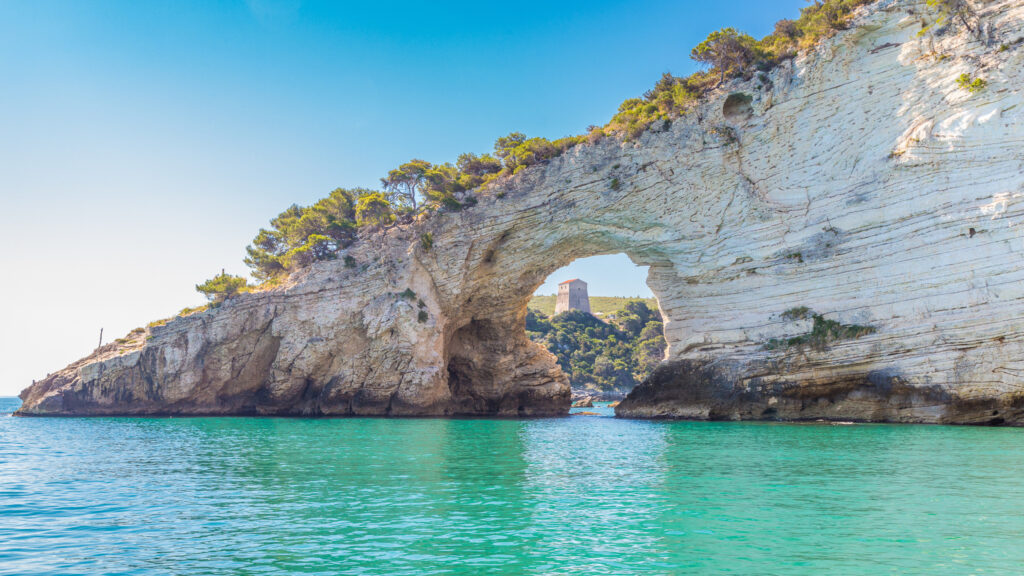
Vieste is one of the best hidden beach towns in Italy, as it is mostly known to windsurfers for its steady winds. Art lovers and history buffs will appreciate the Sfinalicchio, a graffiti dating back to 10000-9000 AD.
Numana, Marche
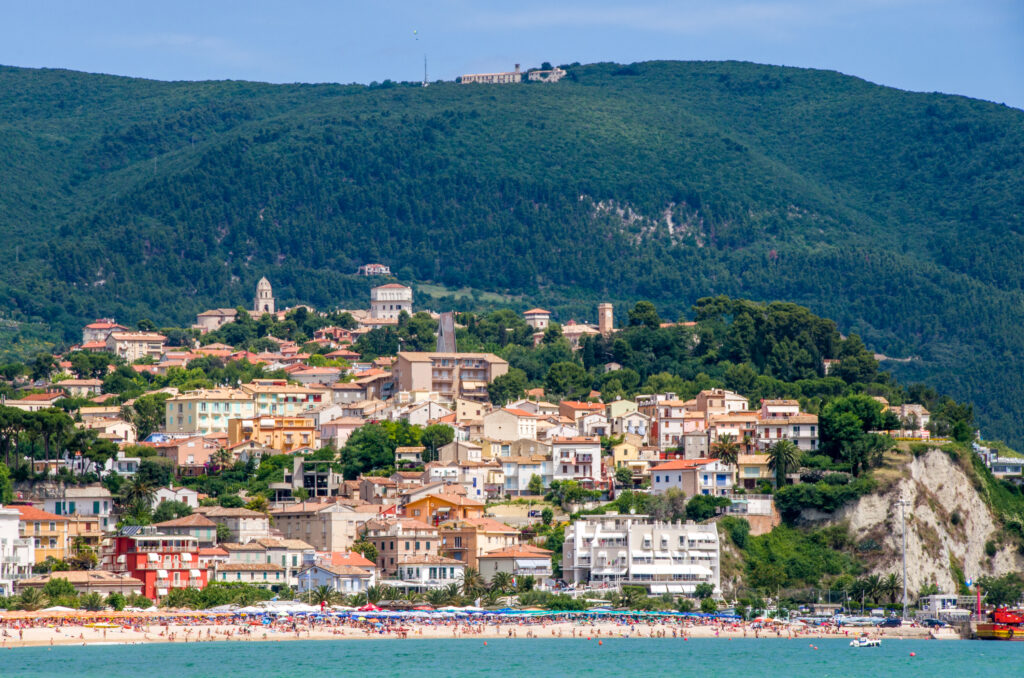
Located in the middle of the Adriatic coast, this beautiful Italian coastal town offers museums, fountains, and the ancient ruins of a Roman aqueduct. But perhaps most famously, it’s known as the “city of turtles” because of its dedication to the preservation of Loggerhead Sea Turtles. In the summer months, you can take excursions to take part in the conservation and release of rehabilitated sea turtles at Sorelle Beach.
The Love’s Bench is the perfect spot to gaze out onto the sea and watch the sunset over the water while holding on to your loved one – whether that be a person or a cone of gelato. From there, you can descend to one of the two beaches to enjoy a relaxing swim.

The self-proclaimed “Heart of the Conero”, Numana offers more than a dozen paths through the Conero National Park to discover on foot or bike. Whether you are looking for a light stroll or a day-long trek, it is one of the best seaside towns in Italy for exploring nature and water alike.
Venice, Veneto

Venice probably isn’t the first Italian town you think of when contemplating coastal villages and resorts, but there are plenty of reasons why you’ll want to add the floating city to your itinerary!
Visiting Venice is an ode to the arts – even if you never step foot in any of the city’s galleries or churches. The craft is evident everywhere you look – from the ornate architecture to the hand-carved wooden gondolas, to the light bouncing off the canals… There’s no wonder the Venetian masters took such inspiration from their surroundings.


Combine Venice sightseeing with hopping on a Vaporetto and whizzing to nearby islands to watch artisans blowing glass into impossibly intricate shapes in Murano, or to learn how lace is made in Burano.
A trip to Venice doesn’t mean forgoing beach time either, as the sandy island of Lido di Venezia provides plenty of the best.
Read More: Best Views in Venice / Visiting Venice in Winter
Trieste, Friuli-Venezia Giulia

Bordering Slovenia, Trieste is a seaside town like no other. A unique mix of cultural influences converge here, as is evident in the area’s architecture, cuisine, and linguistic diversity. Once a vibrant port of the Austrian-Hungarian Empire, testaments to this time still stand today, in the form of palaces, castles and piazzas.
Trieste has been home to several notable writers and intellectuals over the years also, with James Joyce and Italo Svevo having met and formed a friendship here in the early 1900s.

Today, Trieste is known for its cosmopolitan character, cafe culture, grand gardens and unique foodie scene – again thanks to its unique tapestry of heritage to draw from.
Trieste makes an excellent, somewhat off-the-beaten-path choice for an extended stay in Italy. Visit the city’s attractions and nearby beaches before setting off on a day trip to hit a hiking trail through the karst landscapes nearby, visit the Castello di Miramare, or to discover Muggia – Italy’s best-kept secret.
Read More: Best Things to do in Trieste, Italy
Bonus – Sirmione, Lombardy

While this next town isn’t technically on the coast, it is a waterside town on the beautiful Lake Garda that is too pretty to leave off the list!
A wide trench separates the historic town centre from the mainland, with a short bridge to mainland Italy just barely making Sirmione a peninsula instead of an island.
Enjoy a long and idyllic stroll along the streets of the old town, which is completely car-free. At the tip of the over four-kilometre-long sliver of land, you can find the famous Grottoes of Catullus, the first-century AD ruins of a Roman villa.

Dating back to the 14th century, the Scaligero Castle is one of the best-preserved castles in Northern Italy. Built directly into the water, it hosts its own harbour basin, which is truly a sight to behold.
There are probably more beautiful Italian coastal towns than one can ever hope to visit in a lifetime, each offering unique charm and different specialities. But just because you can’t see them all, that doesn’t mean you can’t get started with our top suggestions!




